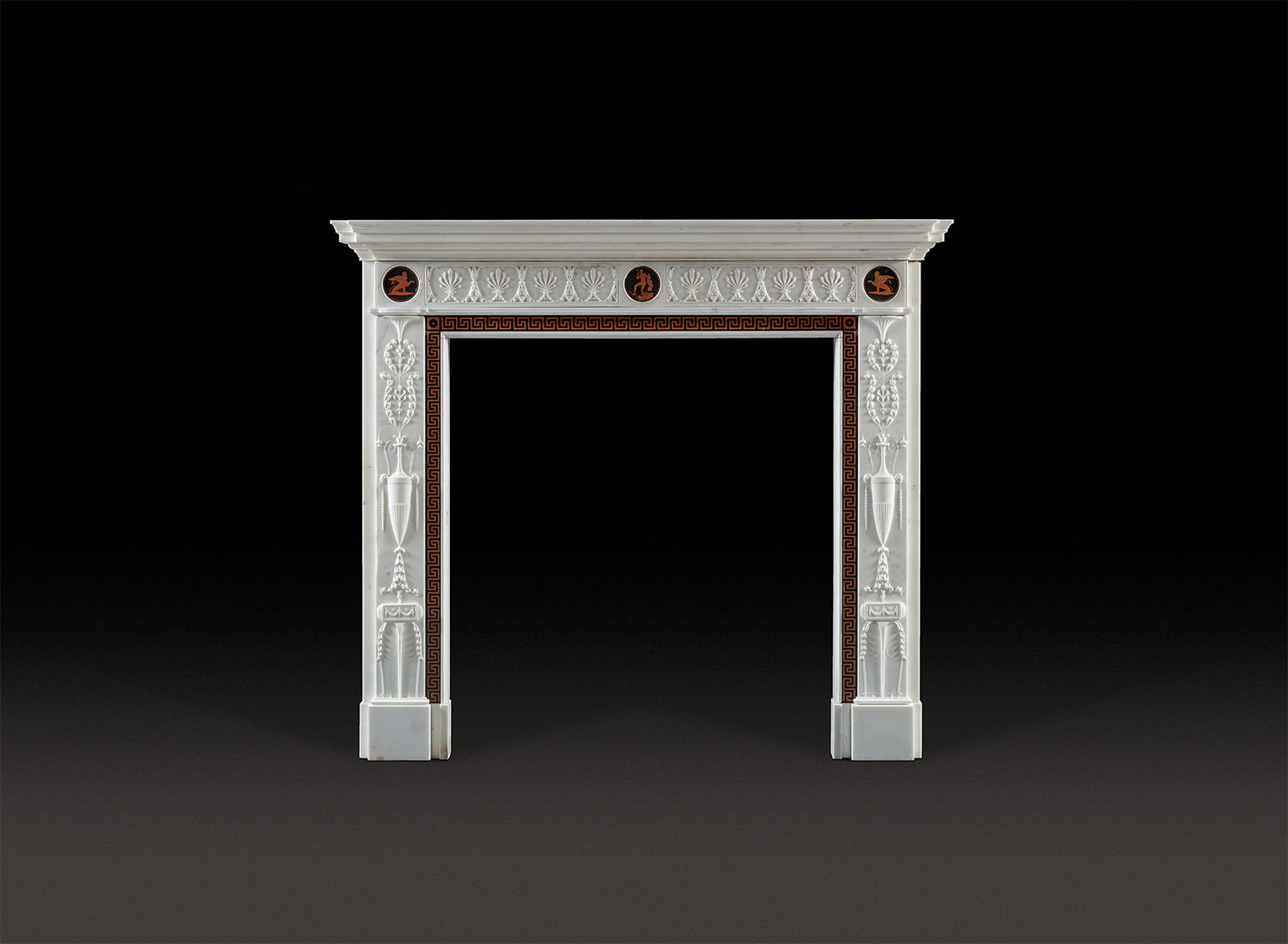
G333
A Masculine, George III, Neoclassical Chimneypiece of White Statuary Marble
A superb and rare George III, Neoclassical fireplace, after a design by Robert Adam (1728–1792) in statuary marble with inlaid Etruscan style panels, with scagliola in orange terracotta shades on a dark background. The surround attributed to John Hinchliffe, with inlay work by the Bartoli/Richter partnership. Circa 1773–4.
With tiered moulded breakfront shelf, the frieze with a central circular scagliola panel depicting a scene from Homer's Odyssey, showing the great Odysseus stealing the Palladium, the sacred image of Athena, from her Trojan temple. Odysseus stands mounting steps, holding the statue in his left hand around his ragged cloak, in his right he holds aloft a spindle, the attribute of Lachesis, one of the three fates who spins the thread of human life. This roundel is flanked by well carved statuary panels bearing bands of stylised palmettes between pairs of budding calyx, the end blockings with circular panels of scagliola depicting winged sphinxes; attributes of wisdom and eternal light with women's heads and lion's bodies, The pilaster jambs with carved arabesque panels of typical Adam design, with rams headed vases on tripod pedestals terminating with scallop edged lambrequin canopies. The opening framed by scagliola Greek key frets sandwiched and contrasting beautifully between white marble mouldings, the whole raised on rectangular foot blocks.
The Etruscan Style used contrasting colours of white, red and terracotta tones often against a brown/black background, and was inspired by the excavations at Pompeii, Herculaneum and Rome from the mid-18th century. Particularly influential were staggeringly preserved murals and Greek and Etruscan painted pottery, which deeply influenced the decorative arts for many years and manifested itself in all areas of the furnished interior from plaster-work and wall coverings, to pottery and fireplaces. This was popularised by the publication of the massive collection of Sir William Hamilton's, Etruscan, Greek and Roman Antiquities in four volumes between 1766 and 1776 (the collection was later bought by the British Museum) which influenced and inspired Wedgwood and Bentley for their pottery designs from the early 1770s, and for the decoration of fireplaces by George Richardson, a designer and draughtsman who worked for the Adams brothers, A New Collection of Chimneypieces Ornamented in the Style of Etruscan and Roman Architecture in 1781. The style was quickly adopted by the fireplace stone cutters and masons of Dublin who reinterpreted it into the vivid Etruscan style 'Bossi' fireplaces in the 1770/1780s. Bartoli and his partner Richter reputable from Dresden were the leading scagliola makers in the 1770s.
Bartoli arrived from Leghorn before 1761 and was the first worker of scagliola to work on inlaying statuary marble for fireplaces at Burton Constable, 1763. In 1767 he went into partnership with Richter working from premises in Great Newport Street near Leicester Square. They worked chiefly on fireplaces, table tops and architectural columns and pedestals, quickly establishing a good reputation as the ‘best makers of scagliola in England' and being recommended in a letter by
Sir William Chambers (Chambers, Letter Book, BL Ad. MS 41133 vol. 113, 10 July 1768). During the partnership they worked exclusively for Robert Adam executing fireplaces to his designs for 20 St James Sq, 1771 and 1772, with Hinchliffe, Derby House 1774, Northumberland House, 1774, and Osterley Park, 1775, and Home House, 1776/7. The partnership was dissolved around 1777/8, both continuing to work on their own account until the early 1800s.
The chimneypiece was owned in the 20th century by Michael Heseltine, Conservative politician and former Deputy Prime Minister.
Height 59in (150cm) width 67½in (171.2cm)
Internal height 46in (117cm) width 42in (106.8cm)
Footblock to footblock 61½in (156cm)
Depth 6in (15cm)






